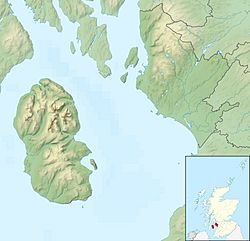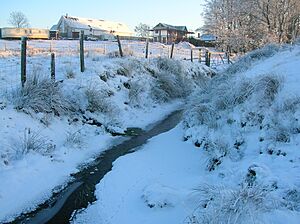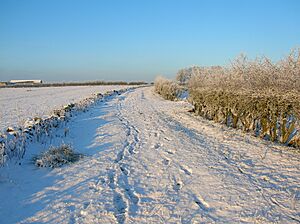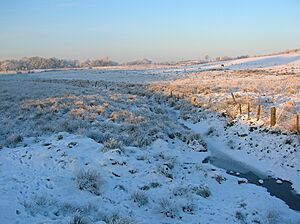Loch Brand facts for kids
Quick facts for kids Loch Brand's site |
|
|---|---|
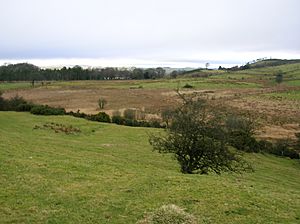
The loch's site from near the ruins of Hill of Beith Castle
|
|
| Location | North Ayrshire, Scotland |
| Coordinates | 55°45′14.2″N 4°36′52.8″W / 55.753944°N 4.614667°W |
| Type | Drained freshwater loch |
| Primary inflows | Grange Burn |
| Primary outflows | Boghall Burn |
| Basin countries | Scotland |
| Surface area | ca. 2 ha (4.9 acres) |
| Islands | One crannog (destroyed) |
| Settlements | Beith |
Loch Brand, also known as Loch of Boghall, was once a freshwater lake in North Ayrshire, Scotland. It was located in a dip in the land between the Grange Estate, Crummock, the Hill of Beith Castle site, and Boghall, near the town of Beith. Water flowed into the loch from the Grange Burn and from rain running off the land. The Boghall Burn drained the loch, flowing past a place called 'Court Hill' and into the Powgree Burn near Gateside.
Contents
History of Loch Brand
Loch Brand was the original name for the Loch of Boghall. This loch was drained in 1780, meaning the water was removed to create dry land. It was one of the sources of the Powgree Burn and was located on the lands of Boghall and Hill of Beith.
Ancient Island Homes
At the bottom of the loch, people have found old wooden piles or stakes made of oak and elm. These are believed to be the remains of crannogs. A crannog is an ancient artificial island, often built in lakes, where people lived. These findings might also be connected to fishing activities that took place on the loch a long time ago.
Draining the Loch
The loch was drained to create more farmland. This process likely started around 1780. The 'cut' through the natural barrier that once held back the loch's water is still easy to see today. The Boghall Burn now flows through this cut.
Many landowners in Scotland, like Alexander Montgomerie, 10th Earl of Eglinton, started draining lochs and improving their land in the 18th century. They wanted to create more space for farming. The names of nearby places like Bogholm, Bogside, and Boghall clearly show that this area used to be very marshy or boggy.
A Historical Dispute
In 1482, when Loch Brand belonged to the monks of Kilwinning Abbey, a legal disagreement happened. The Abbot and Convent of Kilwinning took legal action against Robert Montgomerie and his brother John of Giffin Castle, along with others. They were accused of "dangerous destruction and down-casting of the fosses and dikes of the loch called Loch Brand." This means they were accused of damaging the ditches and walls that held the loch's water. It's not known what the court decided or how this event affected the loch's size or depth.
Who Owned the Loch?
The loch and the land around it were once owned by the monks of Kilwinning Abbey. Later, the Montgomeries of Broadstone owned the lands of Boghall, which included part of the loch. In 1691, Hew Montgomerie owned these lands, and his son Mathew inherited them.
The loch was part of the Barony of Beith, which was given to the monks in the 12th century. The monks' farm, called a Grange, was located nearby. Later, Hill of Beith Castle was built on land that had once belonged to the monks. By the end of the 17th century, the Cuninghames family had sold the castle and its lands. Around 1798, Hugh Brown of Broadstone bought the lands of Hill of Beith Castle and some of the loch lands.
Current Habitat
Today, the site of Loch Brand is a low, marshy area covered in reeds. It is less than 2 hectares (about 5 acres) in size. Old maps from the mid-19th century show that this area was once farmland, without marsh or bog. However, by 2010, it had become the marshy area we see today.


